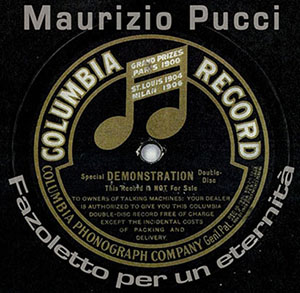Biography Project/Sneeze Symphonies
Commissioned by Deutschlandradio Kultur/Ars Acustica Group. Core text for the biography of the Italian “Sneeze Music” composer Mauricio Pucci who was born a woman but pursued his career as a man in the 1920s. Planned as a 7″ vinyl in December 2019.

Excerpt:
Mauricia “Farfalla” Pucci was born as the forth child of Anna and Paulo Pucci in the Tuscan village Riotorto in 1899. Her father, next to his daily occupation as a cutler was also a renowned village trumpeter. Yet, in favour of the progress of her three older brothers, Mauricia was denied access to formal education, even though her musical talent and her deep interest in composition stood out against the rural petit-bourgeois background. Aged 18, she decided to run away to Naples where she boarded a ship destined to New York. Tall and lean, with somewhat too straight features to be called pretty, unwilling to come to terms with her preordained role as a woman, young Miss Pucci decided to call herself henceforth “Mauricio” and so stepped 1918 onto the shores of the New Word as a free man and aspiring artist.
Pucci’s fate is one of the few known examples in music history that – quite literally – incorporate and transform transgender issues with utmost sensitivity in music. A coincident brought him into contact with the New York composer scene which at the time was much influenced by the new impressionist style purported by composers like Ravel, Debussy and Varese. Soon he made the acquaintance of Charles T. Griffes… and fell madly in love with him. Griffes, then 35, took instantly to this young, dark-eyed and strangely shy stranger. He was just at the turn to become one of the most acclaimed modern composers of his time and exerted a considerable influence on Mauricio, returning the tender feelings but most carefully hiding the fact that he was indeed gay. Such one of the most wondrous and secret romances in the composer world started… a love that was destined to last little more than a year. Griffes, feverishly working on a set of new compositions that he declared to become his ulterior work and the first modern piece that would “be more physical than any other hence written score”, died on April 8, 1920 of a combination of pneumonia, exhaustion and influenza. Charles’ death left Mauricio in a state of shock from which he would never recover but which – at last – holds the clue and initial inspiration for some of the most unusual compositions ever created in the fore field of Modern Music.
Pucci left New York only two months later to return to Naples where he introduced himself convincingly as a distant cousin of the Riotorto Pucci clan. Hardly any records of his activities remained with the family. It was said that beside his composing activities he earned a living as a teacher of the English language. No one suspected that behind the appearance of this erudite, softly spoken and extremely sensitive man lay the physical realities of a woman. In 1921, Mauricio conceived of a set of partly impressionist partly corporeally inspired compositions connected to the most terrifying event of his life: His lover’s influenza and ensuing death. The very pains, the fever, the sneezing, the snorts and moans, the heavy last breaths witnessed at Charles’ sick bed had left their ineradicable musical imprint upon his imagination and paved the way for his quest into NEW PANDEMIC MUSIC.
In 1922 he founded his “Orchestra di Starnuti” (Sneeze Orchestra) which put him onto the forefront of modern composers though, sadly, his innovative concept earned him at the time rather laughter and contempt than respect or admiration of his contemporaries. Between 1922 and 1926 he created at least 60 “Sneeze Fantasies”, for arrangements with handkerchief, nose, voice, trombone, trumpet, theremin and clarinet. While the instrumental parts had a score the “physical” acoustic elements, e.g. sneezes, were only notated as superimposed instructions. For the realization of his compositions, let alone any kind of recording, Maurizio had to rely on voluntary aid of sympathetic friends and supportive relatives who would partake despite their weakened health.
The combination of unpredictable live elements with a score that drew just as much on emphatic re-enactment as it challenged the virtuosity of the instrumentalists made it almost impossible to set up a “proper concert”. Pucci used wax cylinders to prerecord certain sounds in order to be able to play them back when needed. He experimented with the different properties of space too and was an assiduous visitor of churches and caves. The more he indulged into the musicality of “nasal explosions” and the creation of a PANDEMIC NEW MUSIC the more eccentric he became. Mauricio not only started to stage (and record) spiritualist séances to communicate with his lost love; he even became so obsessed as to distribute infected tissues to his environment in order to ensure sufficient flu infections.
…[musical analysis of the symphony]
“Fazoletto per un’ eternità“ is not only a rare and early synthesis of impressionist and atonal composition. In terms of gender politics and history it is one of the earliest examples of “physical generalities” taking their stance within the field of music. But thirdly and foremost it is a recording that incorporates the very vulnerability and timeliness of our existence.
Research, restauration and digitalisation of sound material: Sisukas Poronainen. Department of musical anthropology, Tami University of Finland. Research partner: UCSB Cylinder Audio Archive, USA. © Poronainen. January 2017.
